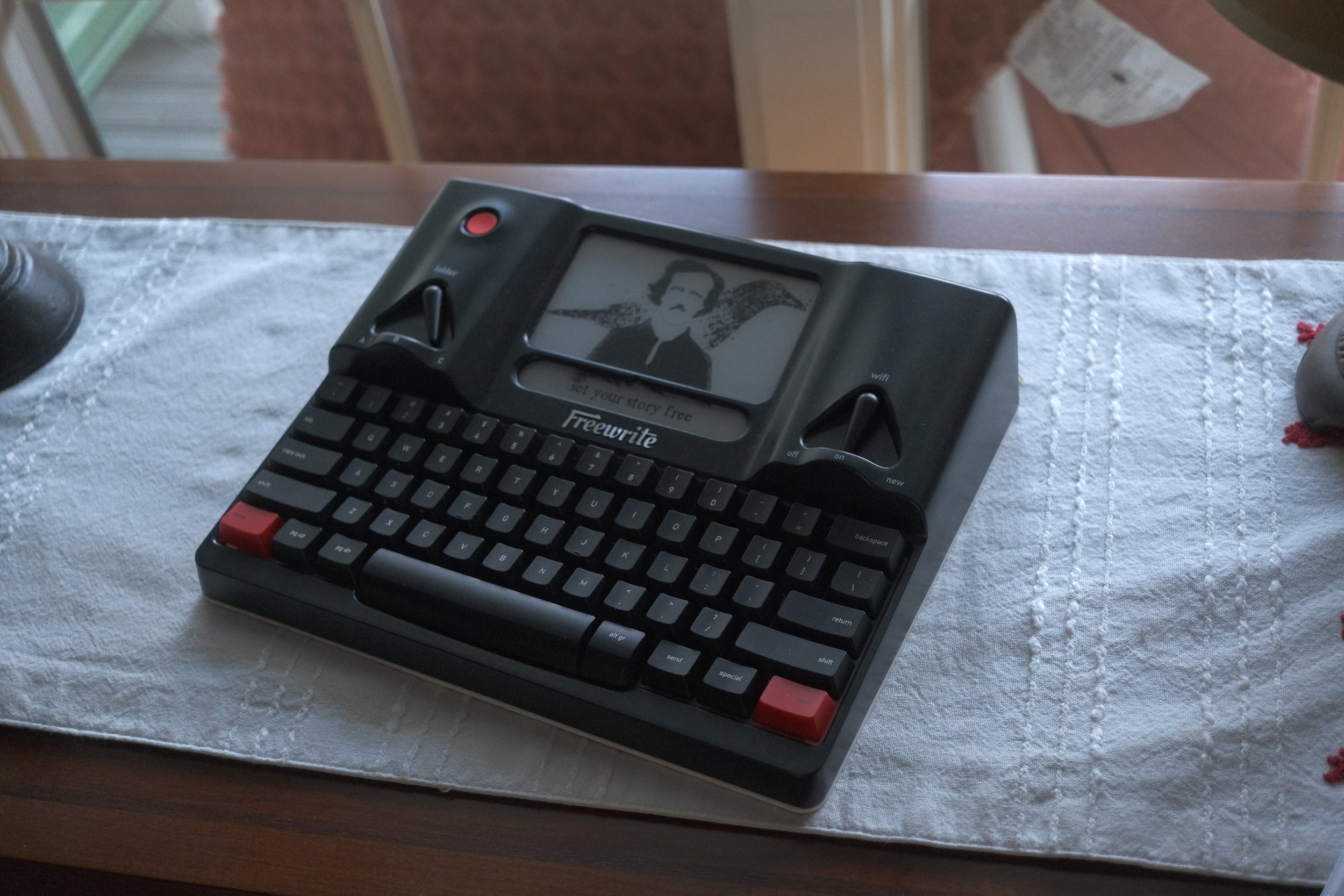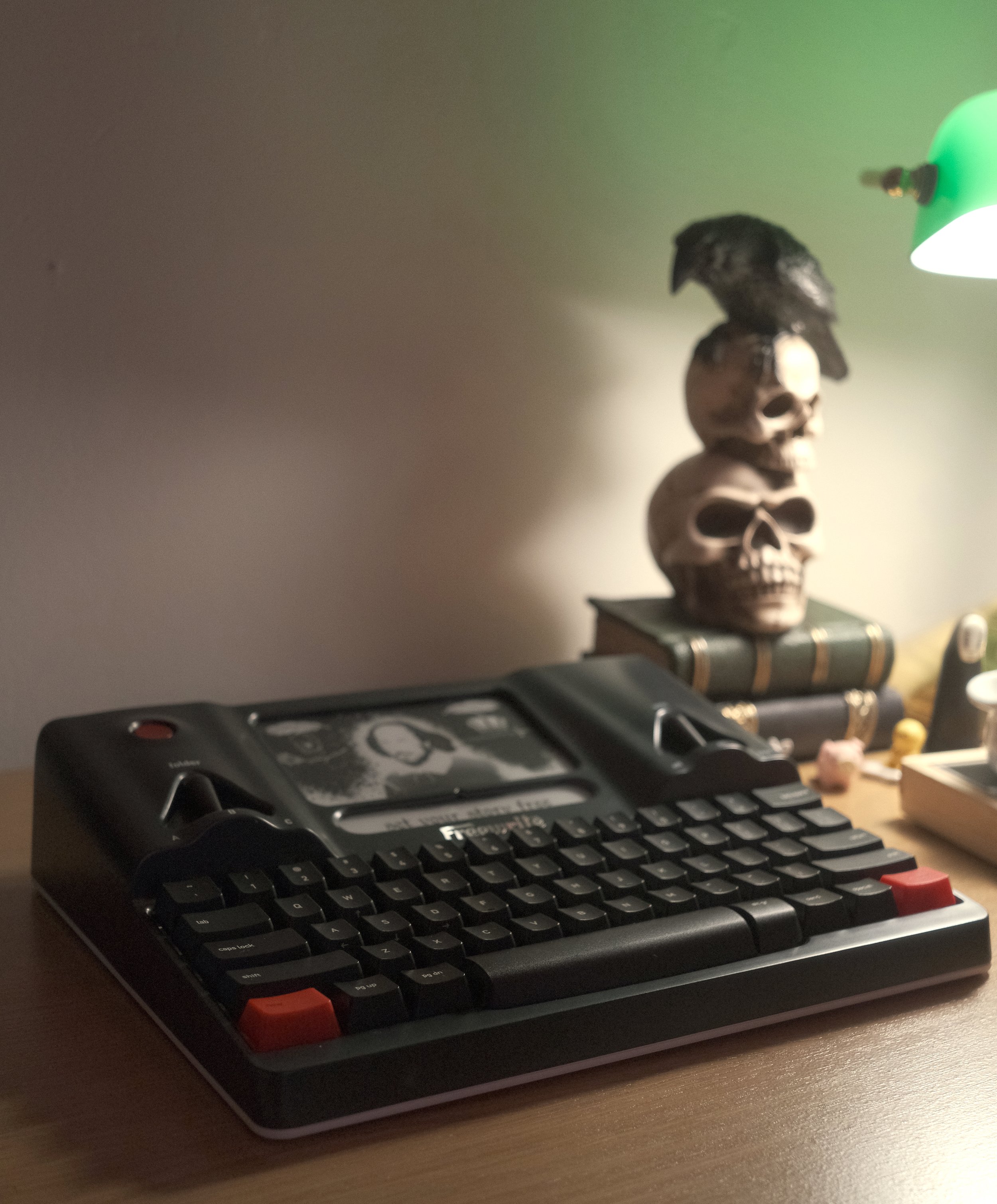When I was in the throes of my time in undergrad at Portland State, I found myself in a predicament. I had a writing station that doubled as my office for schoolwork, yet I found that I was too easily tempted by a variety of other mediums and things to do in my office; I could play video games on my computer, surf the internet, or watch a variety of YouTube videos at any time instead of writing. I was sort of reaching a limbo point in my writing practice; work only came days before the deadline and in spurts rather than all at once, and inspiration came few and far between. I was beginning to lose steam for the artform I once adored. But one day, I got an ad while I was browsing the internet.
Astrohaus' Freewrite is a tool that promises a completely distraction free workflow for writing. When I first saw the device, I was instantly drawn to how distinctive and aesthetically pleasing the device was, with a simple throwback to the true times of distraction free writing by modeling it after a typewriter. The E-ink screen promised no harsh blue light on the eyes, and there’s enough storage on the device to write with unlimited potential. I was incredibly drawn to the device, but shelved my need for it during the spring semester as I was busy with trying to graduate.
However, when I graduated, I wanted to gift myself something as a reward for working hard and writing for four years straight, even during a pandemic when it seemed there was no outside world to read whatever I was to come up with. At first I wanted a traditional typewriter to write with, but then realized the convenience would be a problem for me, as it was a near hassle to have to deal with ink cartridges, and if I made errors, I would have to go in with whiteout and fix it. I wanted to strip away all the parts of writing that were distracting to me, not create new hassles. So, when I moved home, I took my graduation money and spent it on the Gen 3 model of the Freewrite.
Something that I appreciated when buying the Freewrite was the ability to split the payments, as I didn't want to spend all of my graduation money in one go. I split the total cost over four payments which enabled me to get the Freewrite while also making it not such a dent in my wallet. I bring it up here in case anyone is hesitant about the price of such a device; there are options that I think, once realized, may actually be the final thing holding back others from purchasing this.
When I first picked the Freewrite up out of its box, I realized just how light the device was for what it purportedly was made out of. It was a heavy, sturdy device for sure, but when I picked it up by the handle, it felt like I was holding one of those zipping binders you would've carried in middle school.
The startup of the device was incredibly simple as well. I pushed the big red button and the screen booted to life. 'Set Your Story Free' came up on the screen. Little did I know then how real that statement would end up becoming for me and for my craft.
I setup the Freewrite with their software called Postbox, which enables you to sync your writing across various platforms for later editing, a part of the mantra for this device: Write now. Edit later. I chose to sync it up with my Google Drive account, which I already had been writing on for the years that I was in undergrad. I made a new folder called Postbox, and linked it on Postbox's website. In fact, it allowed me to automatically make my account by signing in with Google, which hastened the process of getting everything setup by a lot.
From there, I setup my Freewrite with three folders. Folder A was meant for whatever main project I was working on and all documents associated with that. Folder B was my miscalleneous fiction folder, where I could write side projects, other short stories, and stories from writing prompts. Folder C was meant as my personal folder, where I used the Freewrite as a journal or to draft writing that isn't a part of my practice, like letters to friends and family.
The Gen 3 Freewrite is different from the previous versions because this new model has the ability to move the cursor around inside your document if you notice that you have a spelling error that you absolutely *have* to fix. Trust me, I've been there, and Astrohaus must know that too, because it's just inconvenient enough that it dissuades me from being nitpicky about my word choice when writing, or if things don't sound right. Write now. Edit later.
There is also a new navigation menu where you can see every document in each of your folders and select which one you'd like to work with. Previously, the navigation was done on Postbox off of the device, but here it allowed me to have an almost mini workstation. I like to have a large view of all the documents and writing I'm working on, so that is something I continue to enjoy.
One of the largest concerns amongst people that may be hesitant to purchase a Freewrite is the lag between the keyboard and the screen when typing. Truthfully, I was one of those people that was worried about what that would be like. In fact, I made sure to double, triple check the return policy for this in case I wasn't fond of that aspect of it, as that was my only problem with it besides the cost. I wasn't going to enjoy writing on a device that was going to have trouble keeping up with my typing speed. But as soon as I powered the Freewrite on and opened my first document, I quickly noticed, quite literally within the first minute of using it, that it wasn't that bad at all. I don't know about the previous models, but this screen is definitely quick enough to have that lag issue not be a problem at all.
One of my favorite features of the Freewrite is just how quickly I can get to a new blank document. Ideas never wait for you to boot up Google Drive, but with the Freewrite, I find them spilling on the page just as I'm able to power it on and press the other two red buttons at the bottom of the keyboard, marked 'new'. A new document is right there, ready for me to write with. No hassle. No waiting for documents to sync and folders to load. It's always right there to catch the ideas in my head before they flutter away.
Freewrite is not only a device that changed my writing practice because of its physical presence in my workstation, a device that does nothing but write, but also because of the new philosophy that it's given that practice. When I have an idea, there is no hesitation. The ideas come in an orderly fashion and march to their little folders where I know they'll sync with Google Drive so I don't have to worry about them. I can focus on what's most important, getting the words on the page and, ironically, setting my stories free.








